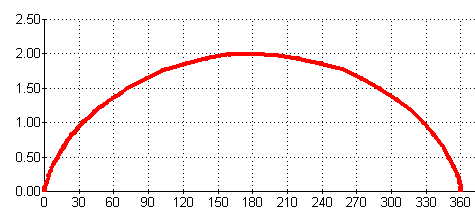|
CYCLOID : Exploration
We have seen how the cycloid is generated by a point on a circle of radius a rolling along the x-axis. The cycloid illustrated above has a = 1. (How can we tell this?) This generation of the cycloid tells us that the distance between two adjacent cusps (where the curve meets the x-axis) is 2
x = a (t – sin t), y = a(1 – cos t), 0 Let us prove this in the case a = 1. Since the circle has radius 1, and is rolling along the horizontal axis, OQ equals the length of arc PQ , and this is equal to the angle PCQ. Let us call this measurement t (for the angle, measured in radians). We now calculate the coordinates of the point P. Working from the point Q, and using the illustrated position of P, we obtain x = t – sin ( You can check that these parametric formulae continue to hold for other positions of P. It can also be shown that the area of the region bounded by a single arch of the curve and the x-axis is 3 A tautochrone or isochrone curve is the curve for which the time taken by an object sliding without friction to its lowest point is independent of its starting point. It is unclear how this problem actually arose. Even the existence of such a curve is not obvious. You can find a mathematical solution to the problem in this Wikipedia reference: http://en.wikipedia.org/wiki/Tautochrone_curve , but it is quite difficult. The above animated gif comes from this Wikipedia page. [Note on the applet: This applet illustrates the result because it has been constructed to do so! In fact, the velocities of the points P and K are not accurately portrayed here.] The brachistochrone property A property of the cycloid related to the tautochrone property is the brachistochrone problem: http://mathworld.wolfram.com/BrachistochroneProblem.html BIBLIOGRAPHY Wikipedia : http://en.wikipedia.org/wiki/Cycloid Wolfram MathWorld : http://en.wikipedia.org/wiki/Cycloid |

 The cycloid has parametric equations
The cycloid has parametric equations The solution of the tautochrone problem, that is, the attempt to identify this curve, was solved by Christiaan Huygens in 1659. He proved geometrically in his Horologium oscillatorium (‘The Pendulum Clock’, 1673) that the cycloid has this property. We might note that around this period, there was great interest in applying mathematics to all sorts of physical and mechanical problems.
The solution of the tautochrone problem, that is, the attempt to identify this curve, was solved by Christiaan Huygens in 1659. He proved geometrically in his Horologium oscillatorium (‘The Pendulum Clock’, 1673) that the cycloid has this property. We might note that around this period, there was great interest in applying mathematics to all sorts of physical and mechanical problems.